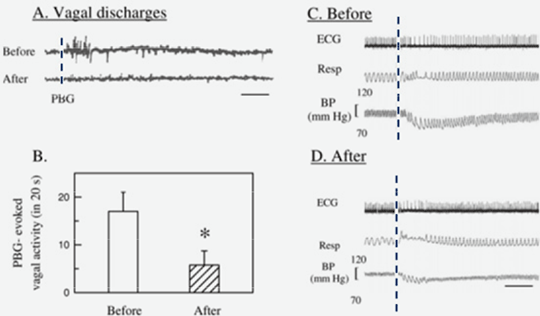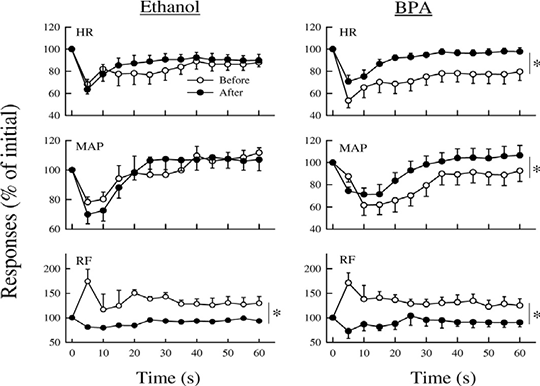Acute Exposure To Bisphenol A Attenuates Phenylbiguanide Evoked Cardio-respiratory Reflex Response In Anaesthetized Rats Bisphenol A (BPA) is a chemical used in the manufacturing of plastics. BPA is an estrogenic compound and is associated with reproductive and endocrinal abnormalities in various studies. Further high urinary levels of BPA have been co-related with heart diseases, liver defects as well. Recently, BPA is also reported to produce respiratory arrest and hypotension after a latency. The latency was similar to the reflex apnoea induced by the vagal C fibre stimulation. Therefore, the present study was undertaken to examine the effects of acute exposure to BPA on cardio-respiratory reflexes elicited by phenylbiguanide (PBG). Acute experiments were performed on adult female rats of Charles Foster strain after obtaining clearance from institutional ethical committee. The experiments were divided into 3 groups. In group 1 (n =8), the animals were anaesthetized with urethane (1.5 gm/kg body weight; intraperitoneal) and prepared for recording blood pressure, ECG and respiratory excursions. After stabilization, PBG (10 µg/kg body weight) was injected through jugular vein to evoke reflexes in these animals. Thereafter, the PBG reflexes were obtained after 30 min of injecting BPA (35mg/kg body weight; i.v.). Similarly, in group 2 (control group, n =7), PBG reflexes were obtained after injecting equi-volumes of ethanol as used to prepare BPA solution. In group 3 (n=4), vagal afferent activity was recorded with PBG reflex response simultaneously. Acute exposure of animals to BPA (35 mg/kg body weight) for 30 min attenuated the PBG-induced responses significantly whereas there was no change in response in ethanol treated animals. The attenuation of the PBG reflex responses by BPA was associated with a significant decrease in vagal afferent activity. The attenuation of reflexes may be due to decreased afferent/efferent activity or the depression of medullary centres. Since PBG is known to act at regenerator region (conducting pathway) it is likely that BPA decreases the transmission of impulses. The present results therefore indicate that BPA attenuates the protective cardio-respiratory reflexes due to decreased vagal afferent activity. 
Fig1. BPA attenuated PBG evoked reflex response due to decreased vagal afferent activity. The dashed line marks PBG injection. * p < 0.05 (Student’s t-test for paired observations) 
Fig 2. BPA attenuated PBG evoked reflexes whereas ethanol did not (*p <0.05, 2-way ANOVA) 1. Calafat AM, Ye X, Wong LY et al.(2008) Environ Health Perspect 116:39-44. 2. Melzer D, Rice NE, Lewis C, et al. (2010) PLoS One 5 345 e8673. 346 |



